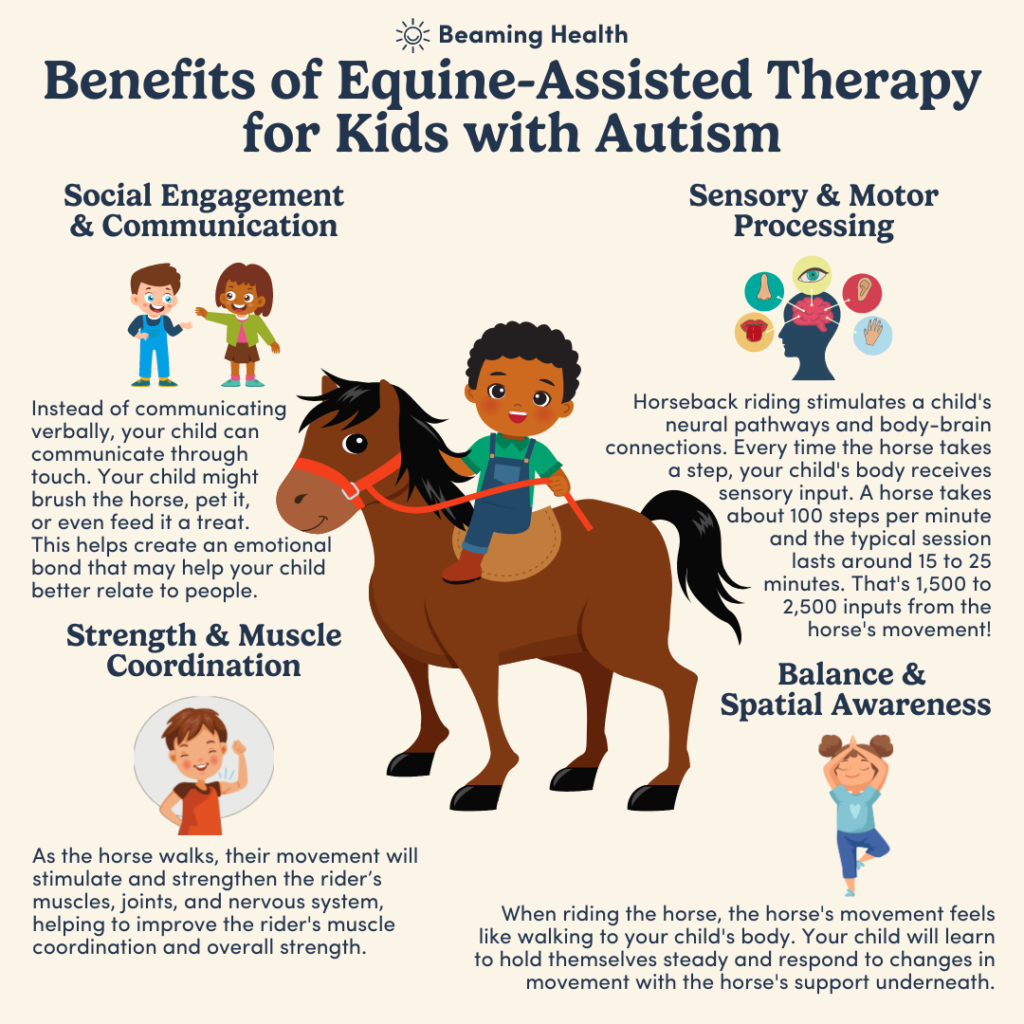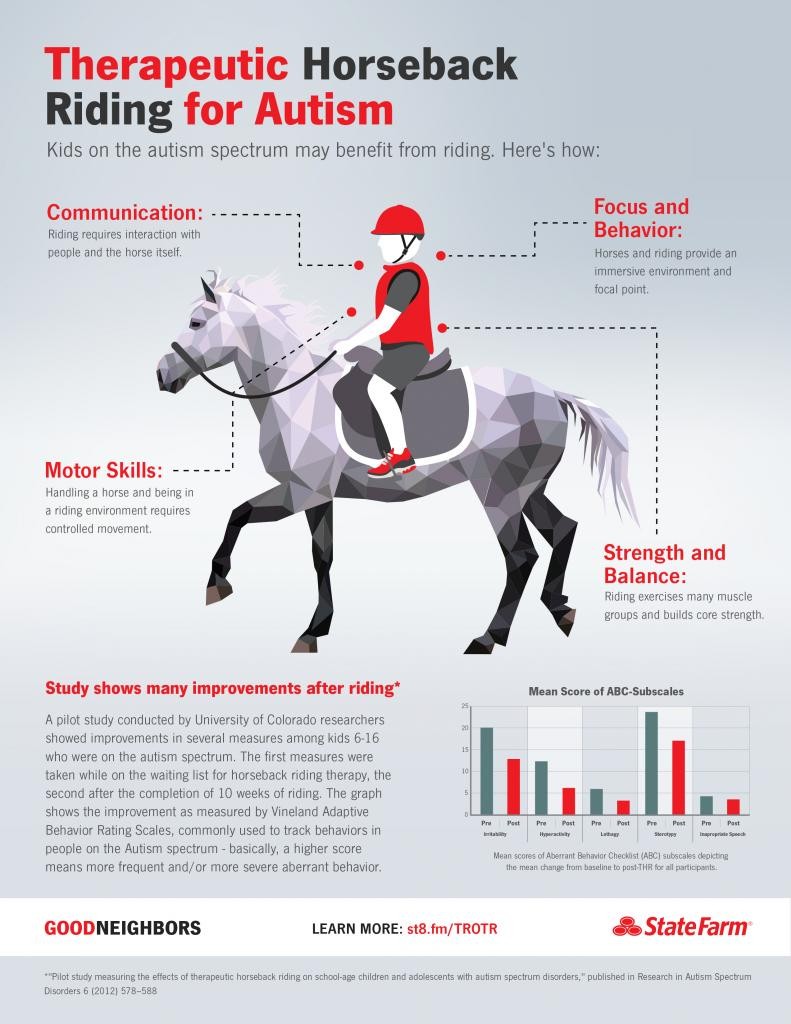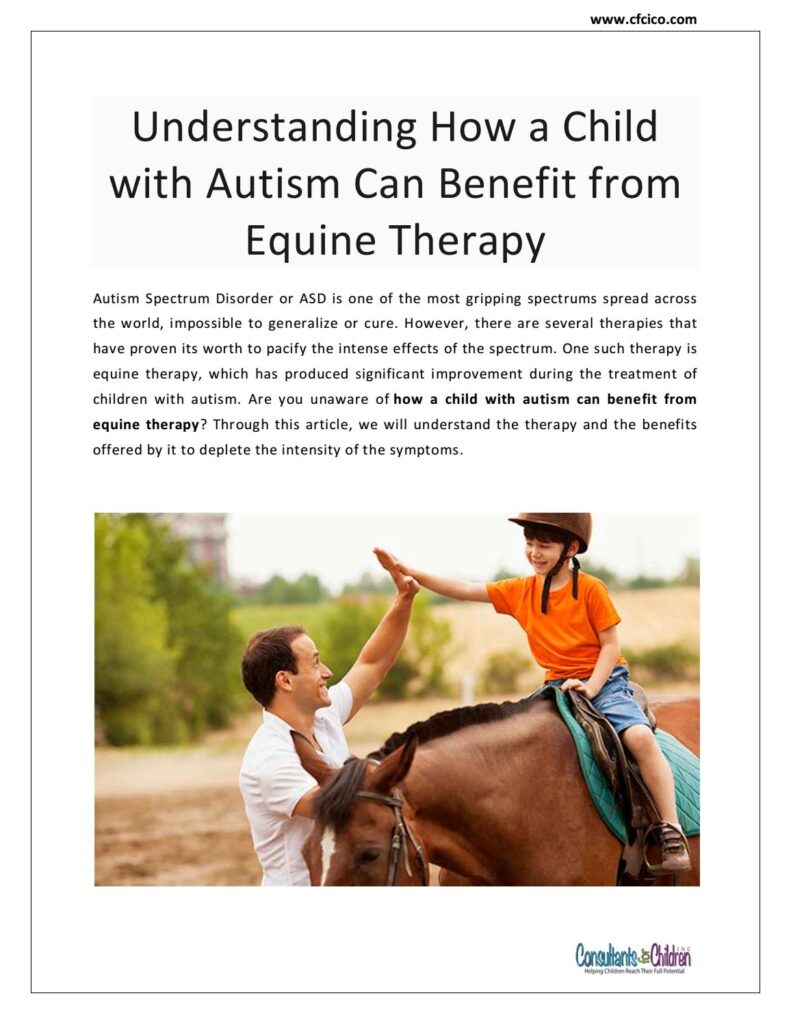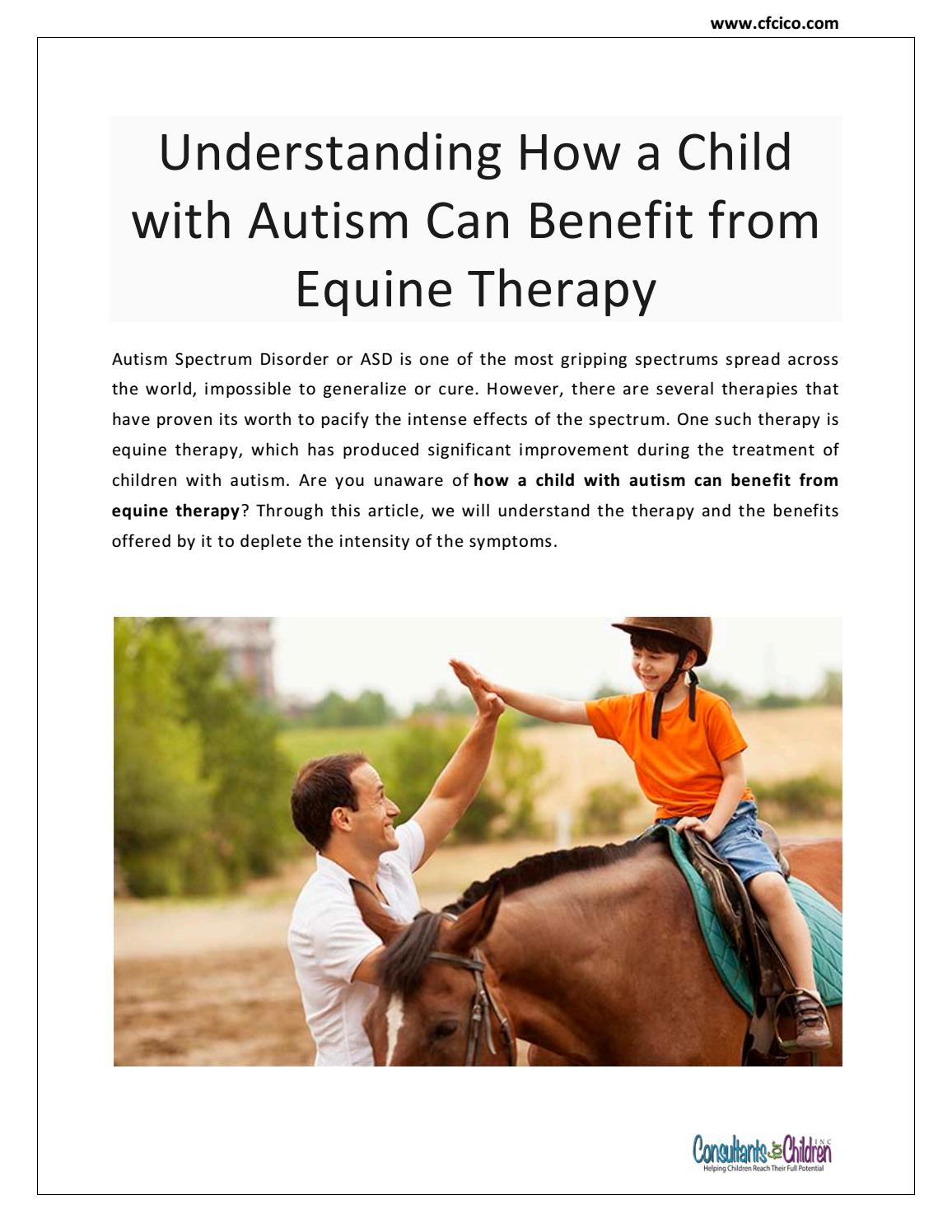Have you ever wondered how horseback riding can benefit children with autism? It might not be the first thing that comes to mind when you think about therapeutic interventions, but it turns out that horseback riding can have a positive impact on children with autism. In this article, we’ll dive into the benefits of horseback riding for children with autism and explore why it can be a valuable activity for them.
When it comes to children with autism, horseback riding can provide a range of benefits. Firstly, the rhythmic motion of the horse can have a calming effect on children with sensory sensitivities, helping to reduce anxiety and meltdowns. Additionally, horseback riding can help improve balance, coordination, and muscle strength, which are areas that children with autism often struggle with. The interaction with the horse also promotes social skills, as the child needs to communicate effectively with the horse and engage in nonverbal cues. These are just some of the benefits, and in our upcoming article, we’ll explore them in more detail and provide you with a comprehensive understanding of the positive impact horseback riding can have on children with autism. Stay tuned!
The Benefits of Horseback Riding for Children with Autism

Introduction
Horseback riding, also known as equine-assisted therapy or therapeutic riding, has gained recognition as an effective intervention for children with autism. Autism is a developmental disorder characterized by social interaction and communication challenges, as well as restricted and repetitive behaviors. In recent years, the therapeutic benefits of horseback riding have become increasingly evident, offering children with autism a unique opportunity for growth and development. In this article, we will explore the numerous benefits of horseback riding for children with autism, ranging from improved motor skills to enhanced communication and social interaction.
Understanding Autism
Definition and characteristics of autism
Autism, or Autism Spectrum Disorder (ASD), is a neurodevelopmental disorder that affects communication, social interaction, and behavior. The characteristics of autism can vary widely from person to person but often include challenges in social interaction, difficulty with verbal and non-verbal communication, repetitive behaviors, and sensory sensitivities.
Prevalence of autism in children
According to the Centers for Disease Control and Prevention (CDC), autism affects an estimated 1 in 54 children in the United States. This prevalence has been steadily increasing over the years, highlighting the need for effective interventions and support for children with autism.
Challenges faced by children with autism
Children with autism face unique challenges in their daily lives. They may struggle with forming social connections, understanding and expressing emotions, and participating in various activities. These challenges can affect their overall development and quality of life.

Benefits of Horseback Riding
Physical benefits of horseback riding
Horseback riding provides numerous physical benefits for children with autism. The rhythmic movement of the horse stimulates the muscles and joints, improving balance, coordination, and strength. The act of riding also encourages proper posture and alignment, enhancing overall physical well-being.
Emotional benefits of horseback riding
Engaging with horses in a therapeutic setting can have a profound impact on a child’s emotional well-being. The bond formed between a child and a horse can foster a sense of trust, empathy, and emotional connection. Interacting with a gentle and non-judgmental animal can help children with autism develop a positive and nurturing relationship, boosting their self-esteem and self-confidence.
Social benefits of horseback riding
Horseback riding provides valuable opportunities for social interaction. In a therapeutic riding program, children can engage with instructors, volunteers, and fellow riders, creating a supportive community. Through these interactions, children with autism can practice and develop essential social skills, such as taking turns, following instructions, and cooperating with others.
Improvement in Motor Skills
Enhancement of balance and coordination
Horseback riding requires the rider to engage their core muscles and maintain balance. The rhythmic movements of the horse challenge the rider’s balance and coordination skills, leading to improvements over time. These enhanced motor skills can have a positive impact on various aspects of a child’s life, from everyday activities to participating in sports and recreational activities.
Development of fine motor skills
In addition to gross motor skills, horseback riding also promotes the development of fine motor skills. Activities such as grooming and handling reins require precise hand-eye coordination and dexterity, helping children improve their fine motor skills. These skills can transfer to other areas of their lives, such as writing, drawing, and self-care tasks.
Strengthening of core muscles
Horseback riding engages the rider’s core muscles as they work to maintain balance and stability. The continuous adjustments required during riding help strengthen the muscles in the abdomen, back, and pelvic area. Strong core muscles not only improve posture and stability but also contribute to overall physical strength and endurance.

Sensory Integration
How horseback riding engages the senses
Horseback riding provides a multisensory experience, engaging various senses simultaneously. The rhythmic movement of the horse stimulates the vestibular system, providing proprioceptive input and promoting body awareness. The tactile experience of touching and interacting with the horse’s coat and mane offers sensory stimulation, while the sounds of the environment and horse’s hooves provide auditory input.
Improving sensory processing
Children with autism often experience sensory processing difficulties, where they may be hypersensitive or hyposensitive to certain sensory stimuli. Horseback riding can help children regulate their sensory responses by exposing them to controlled sensory input. The gentle and predictable movements of the horse can help desensitize hypersensitive children and provide sensory stimulation for hyposensitive children.
Reducing sensory hypersensitivity
Many children with autism struggle with sensory hypersensitivity, where they may feel overwhelmed or distressed by certain sounds, textures, or movements. Horseback riding can help reduce sensory hypersensitivity by gradually exposing the child to sensory stimuli in a controlled and supportive environment. Over time, this exposure can lead to desensitization and increased tolerance for sensory input.
Building Emotional Connections
Establishing trust and empathy with the horse
Interacting with a horse requires trust and empathy, qualities that can be nurtured through horseback riding. Horses are highly intuitive animals and can sense a rider’s emotions. This unique bond encourages children with autism to develop trust and empathy, fostering emotional connections that can extend beyond their interactions with the horse.
Boosting self-confidence and self-esteem
Success and accomplishment in horseback riding can significantly boost a child’s self-confidence and self-esteem. Overcoming challenges, mastering new skills, and building a positive relationship with the horse can empower children with autism and instill a sense of pride. This newfound confidence can extend to other areas of their lives, contributing to their overall well-being and social interactions.
Promoting emotional regulation
Children with autism often struggle with emotional regulation, finding it challenging to identify and manage their emotions. Horseback riding offers a calming and soothing environment that can help children regulate their emotions. The rhythmic movement of the horse and the supportive presence of the instructor can provide a sense of stability and security, aiding in emotional regulation.

Enhancing Communication Skills
Improving non-verbal communication
Horseback riding relies heavily on non-verbal communication between the rider and the horse. To properly guide the horse, riders must communicate using body language, gestures, and subtle cues. This practice can help children with autism improve their non-verbal communication skills, as they learn to be aware of their own movements and interpret the subtle signals from the horse.
Practicing verbal communication
In addition to non-verbal communication, horseback riding also provides opportunities for verbal communication. Children can practice giving verbal commands to the horse and engage in conversation with instructors and fellow riders. These interactions encourage the development of language skills, including vocabulary expansion, sentence formation, and expressive speech.
Developing social cues and gestures
Horseback riding offers a unique opportunity for children with autism to learn and understand social cues and gestures. Observing and imitating the movements and actions of instructors and fellow riders can help children with autism navigate social interactions more effectively. By practicing social cues and gestures in a supportive environment, children can gain confidence and improve their social communication skills.
Encouraging Social Interaction
Interacting with other riders
Therapeutic riding programs often involve group sessions, allowing children with autism to interact with other riders. The shared experience of horseback riding can create a sense of camaraderie and shared interest, providing a foundation for social interaction. Through these interactions, children can learn to engage in conversations, take turns, and develop empathy towards their peers.
Building friendships and peer relationships
Horseback riding can serve as a platform for building friendships and peer relationships. The supportive and inclusive nature of a therapeutic riding program can foster connections between children with autism and their fellow riders. Participating in group activities, working together during riding sessions, and sharing common interests can lay the groundwork for lasting friendships.
Participating in group activities
Therapeutic riding programs often include various group activities that promote collaboration and teamwork. By participating in these activities, children with autism can develop social skills such as cooperation, problem-solving, and compromise. Working towards a common goal alongside their peers can strengthen their sense of belonging and improve their ability to navigate social situations.

Providing Sensory Stimulation
Therapeutic effects of horse’s movement
The movement of a horse offers unique therapeutic effects for children with autism. The rhythmic and repetitive motion of the horse’s gait can provide sensory stimulation and promote relaxation. This motion simulates the side-to-side movement of walking and can have a calming and organizing effect on the nervous system.
Stimulating tactile and proprioceptive senses
Horseback riding provides a tactile and proprioceptive experience for children with autism. The texture of the horse’s coat and the act of grooming offer valuable tactile input, which can help children develop sensory awareness. The weight-bearing nature of riding also contributes to proprioceptive input, enhancing body awareness and spatial orientation.
Engaging visual and auditory senses
Horseback riding engages the visual and auditory senses, exposing children to various stimuli in their environment. The sights and sounds of the stable, the presence of other horses and riders, and the natural surroundings provide opportunities for sensory stimulation. These sensory inputs can improve attention, focus, and overall sensory integration.
Creating Routine and Structure
Establishing predictability and stability
Children with autism often thrive in structured and predictable environments. Horseback riding programs offer a consistent routine, providing children with a sense of predictability and stability. Consistent riding sessions, specific tasks, and reliable interactions with horses and instructors can help children with autism feel secure and reduce anxiety.
Fostering a sense of security
Horseback riding promotes a sense of security for children with autism. The presence of a gentle and reliable horse, the support of trained instructors, and the predictable nature of riding sessions can create a safe and comforting environment. This sense of security can help children with autism feel more at ease and open to new experiences.
Enhancing learning and behavior management
The structure and routine of horseback riding programs can enhance learning and behavior management for children with autism. The clear expectations, visual schedules, and consistent prompts used in these programs can facilitate learning and support appropriate behavior. By providing a structured framework, horseback riding programs can help children with autism develop skills and manage their behavior effectively.
Safety Considerations
Properly fitted riding equipment
Ensuring the safety of children with autism during horseback riding is of utmost importance. It is essential to use properly fitted riding equipment, including helmets, safety stirrups, and secure saddles. This equipment should be inspected regularly for any signs of wear or damage to prevent accidents and injuries.
Trained and experienced instructors
Children with autism require specialized guidance and support during horseback riding. It is crucial to work with trained and experienced instructors who have knowledge of autism and its associated challenges. These instructors should be skilled in adapting the riding experience to meet the needs of each child, ensuring their safety and well-being.
Risk assessment and precautions
Therapeutic riding programs should conduct thorough risk assessments and implement appropriate precautions to ensure the safety of children with autism. This includes evaluating the physical and emotional readiness of children, implementing safety protocols, and establishing clear communication systems between riders, parents, and instructors. Regular safety reviews and ongoing supervision are essential to maintaining a safe riding environment.
Choosing a Suitable Program
Evaluating accredited therapeutic riding programs
When choosing a horseback riding program for a child with autism, it is essential to consider accredited therapeutic riding programs. These programs adhere to specific standards and guidelines, ensuring the safety and effectiveness of their interventions. Accreditation can provide assurance that the program is well-equipped to meet the unique needs of children with autism.
Tailoring the program to the child’s needs
Every child with autism is unique, and their riding program should be tailored to their individual needs and goals. It is essential to communicate openly with the riding program staff about the child’s strengths, challenges, and preferences. This information can help design a program that addresses the specific needs of the child, maximizing the benefits of horseback riding.
Considering location and accessibility
When choosing a horseback riding program, it is important to consider the location and accessibility of the facility. Ideally, the program should be easily accessible for the child and their family, minimizing travel time and logistical challenges. Additionally, considering the proximity to supportive services and resources can further enhance the overall experience for the child.
Supporting Research and Testimonials
Scientific studies on the benefits of horseback riding
Numerous scientific studies have explored the benefits of horseback riding for children with autism. These studies have reported improvements in motor skills, sensory processing, social interaction, emotional well-being, and communication. Research continually supports the therapeutic effects of horseback riding as a valuable intervention for children with autism.
Success stories and testimonials from families
Families of children with autism often share their success stories and testimonials regarding the benefits of horseback riding. These firsthand experiences highlight the positive impact that therapeutic riding programs can have on the lives of children with autism. Hearing these stories can provide insight and inspiration for other families considering horseback riding as an intervention.
Professional opinions and endorsements
Professionals in the field of autism and therapy frequently endorse the use of horseback riding as a valuable therapeutic intervention. Occupational therapists, speech-language pathologists, and behavior analysts recognize the unique benefits of horseback riding for children with autism. These endorsements reinforce the significance of equine-assisted therapy in promoting overall development and well-being.
Conclusion
Horseback riding offers a multitude of benefits for children with autism, ranging from physical improvements to enhanced communication and social interaction. The rhythmic movements of the horse, the bond formed with these gentle animals, and the supportive community of therapeutic riding programs create a unique and empowering experience for children with autism. By incorporating horseback riding into the lives of children with autism, we can unlock their full potential and provide opportunities for growth, development, and joy.
